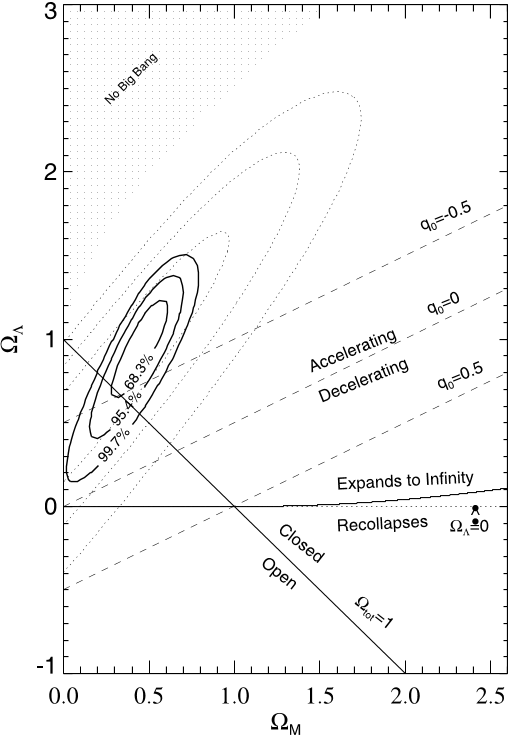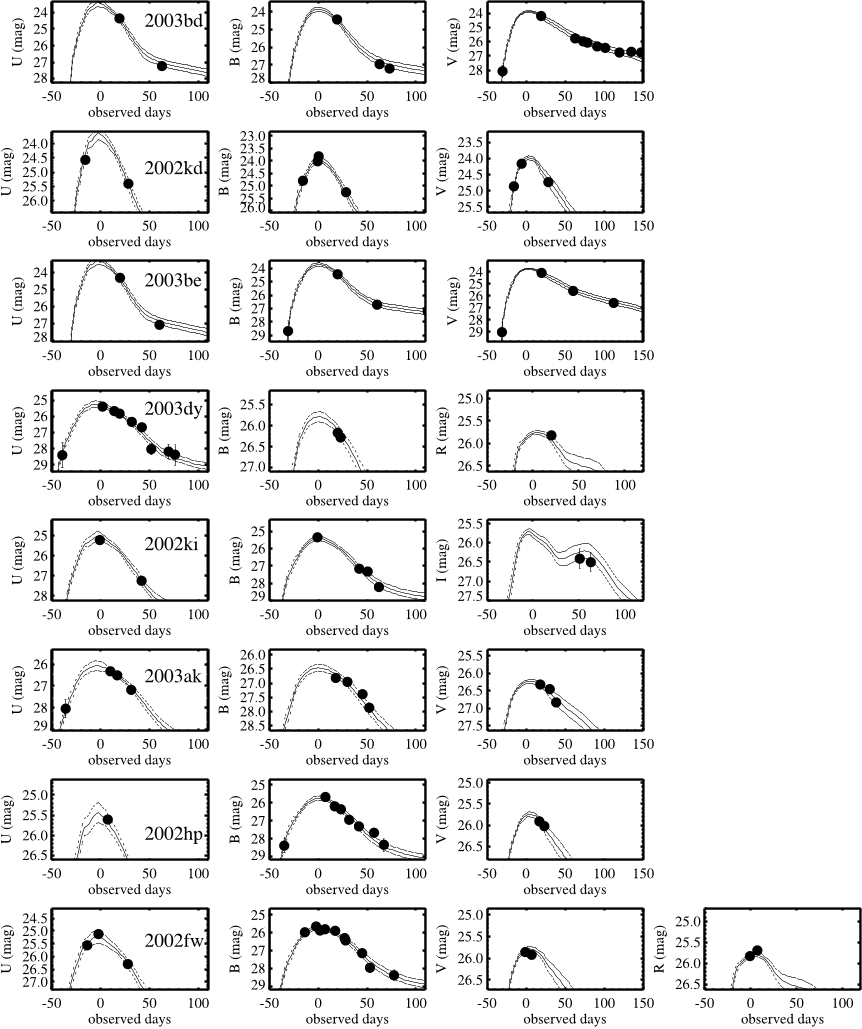Type Ia supernova discoveries at z > 1 from the Hubble Space Telescope: Evidence for past deceleration and constraints on dark energy evolution
Adam G. Riess,Louis-Gregory Strolger,John L. Tonry,Stefano Casertano,Henry C. Ferguson,Bahram Mobasher,Peter Challis,Alexei V. Filippenko,Saurabh Jha,Weidong Li,Ryan Chornock,Robert P. Kirshner,Bruno Leibundgut,Mark Dickinson,Mario Livio,Mauro Giavalisco,Charles C. Steidel,Txitxo Benítez,Zlatan Tsvetanov +18 more
TLDR
For a flat universe with a cosmological constant, the transition between the two epochs is constrained to be at z = 0.46 ± 0.13 as mentioned in this paper, and w = -1.02 ± (and w < -0.76 at the 95% confidence level) for an assumed static equation of state of dark energy.Abstract:
We have discovered 16 Type Ia supernovae (SNe Ia) with the Hubble Space Telescope (HST) and have used them to provide the first conclusive evidence for cosmic deceleration that preceded the current epoch of cosmic acceleration. These objects, discovered during the course of the GOODS ACS Treasury program, include 6 of the 7 highest redshift SNe Ia known, all at z > 1.25, and populate the Hubble diagram in unexplored territory. The luminosity distances to these objects and to 170 previously reported SNe Ia have been determined using empirical relations between light-curve shape and luminosity. A purely kinematic interpretation of the SN Ia sample provides evidence at the greater than 99% confidence level for a transition from deceleration to acceleration or, similarly, strong evidence for a cosmic jerk. Using a simple model of the expansion history, the transition between the two epochs is constrained to be at z = 0.46 ± 0.13. The data are consistent with the cosmic concordance model of ΩM ≈ 0.3, ΩΛ ≈ 0.7 (χ = 1.06) and are inconsistent with a simple model of evolution or dust as an alternative to dark energy. For a flat universe with a cosmological constant, we measure ΩM = 0.29 ± (equivalently, ΩΛ = 0.71). When combined with external flat-universe constraints, including the cosmic microwave background and large-scale structure, we find w = -1.02 ± (and w < -0.76 at the 95% confidence level) for an assumed static equation of state of dark energy, P = wρc2. Joint constraints on both the recent equation of state of dark energy, w0, and its time evolution, dw/dz, are a factor of ~8 more precise than the first estimates and twice as precise as those without the SNe Ia discovered with HST. Our constraints are consistent with the static nature of and value of w expected for a cosmological constant (i.e., w0 = -1.0, dw/dz = 0) and are inconsistent with very rapid evolution of dark energy. We address consequences of evolving dark energy for the fate of the universe.read more
Figures

TABLE 2 SN Ia Imaging 
Fig. 8.—Joint confidence intervals for ( M , ) from SNe Ia. The solid contours are results from the gold sample of 157 SNe Ia presented here. The dotted contours are the results from Riess et al. (1998) illustrating the earlier evidence for > 0. Regions representing specific cosmological scenarios are illustrated. Contours are closed by their intersection with the line M ¼ 0. 
Fig. 16.—Predicted lensing magnifications of SNe Ia and of random positions in the CDF-S and HDF-N. For the SNe Ia discovered in the GOODS fields, the expected magnification was calculated using a multiple-lens plane formalism, with estimates of foreground lens redshifts and masses derived from the GOODS catalog. Expected magnifications were also calculated for 100 randomly selected positions (redshift and angular position). The solid and dotted lines show redshift bin averages and dispersion, respectively. SNe Ia found in the GOODS survey and in other HST searches are indicated. 
Fig. 15.—Comparison of individual distance differences estimated by the MLCS2k2 and BATM methods for the HST and ground-discovered SNe Ia. The zero points of both methods are normalized by using the same set of SNe Ia. 
Fig. 2.—Multicolor light curves of SNe Ia. For each SN Ia, multicolor photometry transferred to rest-frame passbands is plotted. The individual, best-fit MLCS2k2 model is shown as a solid line, with a 1 model uncertainty, derived from the model covariance matrix, above and below the best fit. 
Fig. 17.—Correlation of the predicted magnification and the best-fit cosmological model residual for individual SNe Ia. The predicted magnifications are as described in Fig. 16. The residuals are the difference in distance modulus as predicted from the best-fit model ( M ¼ 0:3, ¼ 0:7) and as observed. The empirical correlation is expected to be unity (if the lens light traces their mass) and is shown for the whole sample and without SN 1997ff, the SN with the largest residual and predicted magnification.
Citations
More filters
Journal ArticleDOI
Wilkinson Microwave Anisotropy Probe (WMAP) three year results: implications for cosmology
David N. Spergel,Rachel Bean,Rachel Bean,Olivier Doré,Olivier Doré,M. R. Nolta,M. R. Nolta,Charles L. Bennett,Charles L. Bennett,Gary Hinshaw,Norman Jarosik,Eiichiro Komatsu,Eiichiro Komatsu,Lyman A. Page,Hiranya V. Peiris,Hiranya V. Peiris,Licia Verde,Licia Verde,M. Halpern,R. S. Hill,A. Kogut,Michele Limon,S. S. Meyer,N. Odegard,Gregory S. Tucker,Jan Weiland,Edward J. Wollack,E. L. Wright +27 more
TL;DR: In this article, a simple cosmological model with only six parameters (matter density, Omega_m h^2, baryon density, BH density, Hubble Constant, H_0, amplitude of fluctuations, sigma_8, optical depth, tau, and a slope for the scalar perturbation spectrum, n_s) was proposed to fit the three-year WMAP temperature and polarization data.
Journal ArticleDOI
Dynamics of dark energy
TL;DR: In this article, the authors review the observational evidence for the current accelerated expansion of the universe and present a number of dark energy models in addition to the conventional cosmological constant, paying particular attention to scalar field models such as quintessence, K-essence and tachyon.
Journal ArticleDOI
Five-year wilkinson microwave anisotropy probe observations: cosmological interpretation
Eiichiro Komatsu,Jo Dunkley,Jo Dunkley,M. R. Nolta,Charles L. Bennett,B. Gold,Gary Hinshaw,N. Jarosik,Davin Larson,Michele Limon,Lyman A. Page,David N. Spergel,Mark Halpern,Robert S. Hill,Alan J. Kogut,S. S. Meyer,Gregory S. Tucker,Janet Weiland,Edward J. Wollack,Edward L. Wright +19 more
TL;DR: In this article, the Wilkinson Microwave Anisotropy Probe (WMAP) 5-year data were used to constrain the physics of cosmic inflation via Gaussianity, adiabaticity, the power spectrum of primordial fluctuations, gravitational waves, and spatial curvature.
Journal ArticleDOI
Detection of the baryon acoustic peak in the large-scale correlation function of SDSS luminous red galaxies
Daniel J. Eisenstein,Daniel J. Eisenstein,Idit Zehavi,David W. Hogg,Roman Scoccimarro,Michael R. Blanton,Robert C. Nichol,Ryan Scranton,Hee-Jong Seo,Max Tegmark,Max Tegmark,Zheng Zheng,Scott F. Anderson,James Annis,Neta A. Bahcall,Jon Brinkmann,Scott Burles,Francisco J. Castander,Andrew J. Connolly,István Csabai,Mamoru Doi,Masataka Fukugita,Joshua A. Frieman,Joshua A. Frieman,Karl Glazebrook,James E. Gunn,John S. Hendry,Greg Hennessy,Zeljko Ivezic,Stephen M. Kent,Gillian R. Knapp,Huan Lin,Yeong Shang Loh,Robert H. Lupton,Bruce Margon,Timothy A. McKay,Avery Meiksin,Jeffrey A. Munn,Adrian Pope,Michael W. Richmond,David J. Schlegel,Donald P. Schneider,Kazuhiro Shimasaku,Chris Stoughton,Michael A. Strauss,Mark SubbaRao,Mark SubbaRao,Alexander S. Szalay,István Szapudi,Douglas L. Tucker,Brian Yanny,Donald G. York +51 more
TL;DR: In this paper, a large-scale correlation function measured from a spectroscopic sample of 46,748 luminous red galaxies from the Sloan Digital Sky Survey is presented, which demonstrates the linear growth of structure by gravitational instability between z ≈ 1000 and the present and confirms a firm prediction of the standard cosmological theory.
Journal ArticleDOI
f ( R ) theories of gravity
TL;DR: In this article, the authors present a review of the most important aspects of the different classes of modified gravity theories, including higher-order curvature invariants and metric affine.
References
More filters
Journal ArticleDOI
The Absolute Luminosities of the Calan/Tololo Type Ia Supernovae
TL;DR: In this article, the absolute luminosities of 29 SNe Ia in the Calan/Tololo survey were examined and a relation between the peak luminosity of the SNe and the decline rate as measured by the light curve was found.
Supernova Limits on the Cosmic Equation of State
Peter M. Garnavich,Saurabh Jha,P. Challis,Alejandro Clocchiatti,A. Diercks,Alexei V. Filippenko,Ronald L. Gilliland,Craig J. Hogan,Robert P. Kirshner,Bruno Leibundgut,Mark M. Phillips,David J Reiss,Adam G. Riess,Brian P. Schmidt,Robert A. Schommer,R. C. Smith,Jason Spyromilio,Christopher W. Stubbs,Nicholas B. Suntzeff,John L. Tonry,Sean M. Carroll +20 more
TL;DR: In this article, the authors used Type Ia supernovae studied by the High-Z Supernova Search Team to constrain the properties of an energy component which may have contributed to accelerating the cosmic expansion.
Journal ArticleDOI
The Absolute Luminosities of the Calan/Tololo Type IA Supernovae
TL;DR: In this article, the absolute luminosities of 29 SNe Ia in the Calan/Tololo survey were examined and a relation between the peak luminosity of the SNe and the decline rate as measured by the light curve was found.
Journal ArticleDOI
A median redshift of 2.4 for galaxies bright at submillimetre wavelengths
TL;DR: Spectroscopic redshifts for ten submm galaxies that were identified using high-resolution radio observations are reported, suggesting a close relationship between the growth of massive black holes and luminous dusty galaxies in the present-day Universe.
Journal ArticleDOI
Twenty-Three High-Redshift Supernovae from the Institute for Astronomy Deep Survey: Doubling the Supernova Sample at z > 0.7 * **
Brian J. Barris,John L. Tonry,Stephane Blondin,Peter Challis,Ryan Chornock,Alejandro Clocchiatti,Alexei V. Filippenko,Peter M. Garnavich,Stephen T. Holland,Saurabh Jha,Robert P. Kirshner,Kevin Krisciunas,Bruno Leibundgut,Weidong Li,Thomas Matheson,Gajus Miknaitis,Adam G. Riess,Brian P. Schmidt,R. Chris Smith,Jesper Sollerman,Jason Spyromilio,Christopher W. Stubbs,Nicholas B. Suntzeff,Herve Aussel,K. C. Chambers,M. S. Connelley,David Donovan,J. Patrick Henry,Nick Kaiser,Michael C. Liu,Eduardo L. Martín,Richard J. Wainscoat +31 more
TL;DR: In this article, photometric and spectroscopic observations of 23 high-redshift supernovae (SNe) spanning a range of z = 0.34-1.03, nine of which are unambiguously classified as Type Ia.
Related Papers (5)
Measurements of Omega and Lambda from 42 High-Redshift Supernovae
Saul Perlmutter,Saul Perlmutter,Greg Aldering,Gerson Goldhaber,Gerson Goldhaber,R. A. Knop,Peter Nugent,P. G. Castro,P. G. Castro,Susana E. Deustua,Sebastien Fabbro,Sebastien Fabbro,A. Goobar,A. Goobar,Donald E. Groom,I. M. Hook,I. M. Hook,A. G. Kim,A. G. Kim,A. G. Kim,M. Y. Kim,Julia C. Lee,Julia C. Lee,Nelson J. Nunes,Nelson J. Nunes,Reynald Pain,Reynald Pain,C. R. Pennypacker,C. R. Pennypacker,Robert Quimby,Christopher Lidman,Richard S. Ellis,Mike Irwin,Richard G. McMahon,Pilar Ruiz-Lapuente,Nicholas A. Walton,Bradley E. Schaefer,B. J. Boyle,Alexei V. Filippenko,Thomas Matheson,A. S. Fruchter,Nino Panagia,Nino Panagia,Heidi Jo Newberg,Warrick J. Couch +44 more
Observational Evidence from Supernovae for an Accelerating Universe and a Cosmological Constant
Adam G. Riess,Alexei V. Filippenko,Peter Challis,Alejandro Clocchiatti,Alan H. Diercks,Peter M. Garnavich,R. L. Gilliland,Craig J. Hogan,Saurabh Jha,Robert P. Kirshner,Bruno Leibundgut,Mark M. Phillips,David J Reiss,Brian P. Schmidt,R. A. Schommer,R. Chris Smith,R. Chris Smith,Jason Spyromilio,Christopher W. Stubbs,Nicholas B. Suntzeff,John L. Tonry +20 more
First year Wilkinson Microwave Anisotropy Probe (WMAP) observations: Determination of cosmological parameters
David N. Spergel,Licia Verde,Hiranya V. Peiris,Eiichiro Komatsu,M. R. Nolta,Charles L. Bennett,Mark Halpern,Gary Hinshaw,N. Jarosik,Alan J. Kogut,Michele Limon,Michele Limon,S. S. Meyer,Lyman A. Page,Gregory S. Tucker,Gregory S. Tucker,Gregory S. Tucker,Janet L. Weiland,Edward J. Wollack,Edward L. Wright +19 more
Detection of the baryon acoustic peak in the large-scale correlation function of SDSS luminous red galaxies
Daniel J. Eisenstein,Daniel J. Eisenstein,Idit Zehavi,David W. Hogg,Roman Scoccimarro,Michael R. Blanton,Robert C. Nichol,Ryan Scranton,Hee-Jong Seo,Max Tegmark,Max Tegmark,Zheng Zheng,Scott F. Anderson,James Annis,Neta A. Bahcall,Jon Brinkmann,Scott Burles,Francisco J. Castander,Andrew J. Connolly,István Csabai,Mamoru Doi,Masataka Fukugita,Joshua A. Frieman,Joshua A. Frieman,Karl Glazebrook,James E. Gunn,John S. Hendry,Greg Hennessy,Zeljko Ivezic,Stephen M. Kent,Gillian R. Knapp,Huan Lin,Yeong Shang Loh,Robert H. Lupton,Bruce Margon,Timothy A. McKay,Avery Meiksin,Jeffrey A. Munn,Adrian Pope,Michael W. Richmond,David J. Schlegel,Donald P. Schneider,Kazuhiro Shimasaku,Chris Stoughton,Michael A. Strauss,Mark SubbaRao,Mark SubbaRao,Alexander S. Szalay,István Szapudi,Douglas L. Tucker,Brian Yanny,Donald G. York +51 more